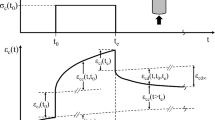Abstract
A moisture gradient develops as concrete dries, inducing a drying shrinkage stress gradient that can lead to early-age cracking in restrained concrete. A new internal relative humidity measurement system was used to quantify the moisture gradient in early-age concrete exposed to drying. A simple model was developed to estimate the stress gradient associated with drying in both free and fully restrained concrete specimens. The model predicts that the stresses in the surface layer of restrained concrete exceed the tensile strength of the material prior to complete specimen failure. Comparison of the model and experimental results indicate that the fully restrained specimens with the most severe drying stress gradients failed at the earliest ages.
Similar content being viewed by others
References
Mindess S, Young JF (1981) Concrete. (Prentice-Hall, New Jersey).
Defay R, Prigogine I, Bellemans A, Everett DH (1966) Surface tension and adsorption. (John Wiley and Sons, Inc., NY).
Hua C, Acker P, Ehrlacher A (1995) Analyses and models of the autogenous shrinkage of hardening cement paste: I. modelling at macroscopic scale. Cem. and Concr. Res., 25:1457–1468.
Bazant ZP, Raftshol WJ (1982) Effect of cracking in drying and shrinkage specimens. Cem. and Concr. Res., 12:209–226.
Altoubat S (2000) Early age stresses and creep-shrinkage interaction of restrained concrete. Ph.D. Thesis, University of Illinois at Urbana-Champaign.
Altoubat S, Lange DA (2001) Creep, shrinkage, and cracking of early age concrete. ACI Mat. J., 98(4):323–31.
Wittmann FH, Roelfstra PE (1980) Total deformation of loaded drying concrete. Cem. and Concr. Res., 10:601–610.
Mackenzie JK (1950) The elastic constants of a solid containing spherical holes. Proc. Phys. Soc., B 683:2–11.
Bentz DP, Garboczi EJ, Quenard DA (1998) Modelling drying shrinkage in reconstructed porous materials: Application to porous vycor glass. Modelling Simul. Mater. Sci. Eng., 6:211–236.
Akita H, Fujiwara T, Ozaka Y (1997) Practical procedure for the analysis of moisture transfer within concrete due to drying. Mag. of Concr. Res., 49(179):129–137.
Xi Y, Jennings HM (1997) Shrinkage of cement paste and concrete modelled by a multiscale effective homogenous theory. Mat. and Struct., 30:329–339.
RILEM Draft Recommendation (1995) Creep and shrinkage prediction model for analysis and design of concrete structures-model B3. Mat. and Struct., 28:357–365.
Østergaard L, Lange DA, Altoubat SA, Stang H (2001) Tensile basic creep of early-age concrete under constant load. Cem. and Concr. Res., 31(12):1895–1899.
D'Ambrosia MD, Lange DA (2005) Modeling early age tensile creep and shrinkage of concrete. ACI SP 227:349–366.
D'Ambrosia MD, Lange DA, Grasley ZC (2004) Measurement and modelling of creep and shrinkage of concrete under stress from shrinkage at early age. ACI SP 220:99–112.
Wittmann FH (1982) Creep and shrinkage mechanisms. chapter 6 in Creep and Shrinkage in Concrete Structures. John Wiley & Sons, Ltd.
Grasley ZC, Lange DA, D'Ambrosia MD (2005) Drying stresses and internal relative humidity in concrete, in materials science of concrete VII. (American Ceramic Society).
D'Ambrosia MD (2002) Early age tensile creep and shrinkage of concrete with shrinkage reducing admixtures. (M.S. Thesis, University of Illinois at Urbana – Champaign).
Hwang C-L, Young JF (1984) Drying shrinkage of portland cement pastes I. microcracking during drying. Cem. and Concr. Res., 14:585–594.
Bisschop Jan (2002) Drying shrinkage microcracking in cement-based material. Ph.D. Thesis, Delft University Press.
Higgins DD, Bailey JE (1976) A microstructural investigation of the failure behaviour of cement paste, in hydraulic cement pastes: Their structure and properties. Proceedings of an International Conference, Sheffield, Eng., 283–296.
Lange DA, Cowen D, D'Ambrosia M, Grasley Z, Lee C-J (2003) High performance concrete for transportation structures. IHR-R29, Illinois Dept. of Trans. Bureau of Mat. and Phys. Res.
Cady PD, Clear KC, Marshall LG (1972) Tensile strength reduction of mortar and concrete due to moisture gradients. ACI J. Title No. 69-68:700–705.
Lura P, Guang Y, van Breugel K (2003) Effect of cement type on autogenous deformation of cement-based materials. ACI SP 220–224:57–68.
Author information
Authors and Affiliations
Rights and permissions
About this article
Cite this article
Grasley, Z.C., Lange, D.A. & D'Ambrosia, M.D. Internal relative humidity and drying stress gradients in concrete. Mater Struct 39, 901–909 (2006). https://doi.org/10.1617/s11527-006-9090-3
Received:
Accepted:
Published:
Issue Date:
DOI: https://doi.org/10.1617/s11527-006-9090-3




